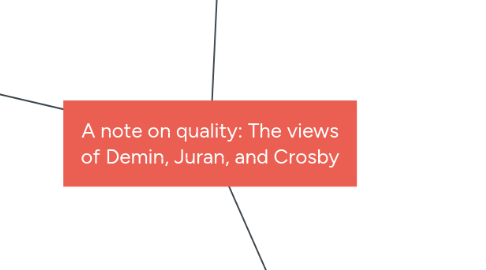
1. Deming
1.1. 14-point program
1.1.1. Improvement of products
1.1.1.1. Constant innovation
1.1.2. A new philosophy
1.1.2.1. No defective products
1.1.2.2. No Poor workmanship
1.1.3. Less mass inspection
1.1.4. Establish new guidelines
1.1.4.1. Longer suppliers relationships
1.1.5. Improvement of systems
1.1.5.1. Improve every activity
1.1.6. Restructuration of training
1.1.6.1. Create acceptable work
1.1.7. Modern supervising methods
1.1.7.1. Inform needed corrections
1.1.8. Drive out fear
1.1.9. No more barriers
1.1.9.1. Everyone's a team
1.1.10. Eliminate numerical goals
1.1.10.1. Increase workers' productivity
1.1.11. Eliminate work standards
1.1.12. No barriers for hourly workers
1.1.13. Institute new programs
1.1.13.1. Continuous peope training
2. Juran (Fitness for use)
2.1. Five major dimensions
2.1.1. Quality of design
2.1.2. Quality of conformance
2.1.3. Quality of availability
2.1.4. Quality of safety
2.1.5. Quality of field use
2.2. Cost-of-quality accounting system
2.2.1. Internal failure costs
2.2.1.1. Defects before shipment
2.2.1.1.1. Scrap, reworl, retest
2.2.1.1.2. Downtime, yield losses, disposition
2.2.2. External failure costs
2.2.2.1. Defects after shipment
2.2.2.1.1. Complaint adjustment, returned material
2.2.2.1.2. Warranty charges, allowances
2.2.3. Appraisal costs
2.2.3.1. Assesing products' condition
2.2.3.1.1. Incoming materials inspection
2.2.3.1.2. Inspection and test
2.2.3.1.3. Test equipment
2.2.3.1.4. Evaluation of stocks
2.2.4. Preventing costs
2.2.4.1. Cease possible defects
2.2.4.1.1. Quality planning, reporting
2.2.4.1.2. New products review
2.2.4.1.3. Training, process control
2.2.4.1.4. Quality data analysis
2.3. Maintain a minimun COQ
2.3.1. By
2.3.1.1. Breakthrough projects
2.3.1.2. A control sequence
2.3.1.3. Annual quality programs
3. Crosby
3.1. Quality is free
3.2. Goal of quality
3.2.1. Zero defects
3.3. Key to quality
3.3.1. Change managers' thinking
3.4. Two primary tools
3.4.1. Management maturity grid
3.4.1.1. Uncertainty
3.4.1.2. Awakening
3.4.1.3. Enlightment
3.4.1.4. Wisdom
3.4.1.5. Certainty
3.4.2. Cost of quality mesures
3.5. Quality improvement program
3.5.1. Management commitment
3.5.2. Quality improvement team
3.5.3. Quality measurement
3.5.4. COQ evaluation
3.5.5. Quality awareness
3.5.6. Corrective action
3.5.7. Zero defects planning
3.5.8. Supervisor training
3.5.9. Goal setting
3.5.10. Error cause removal
3.5.11. Quality councils
